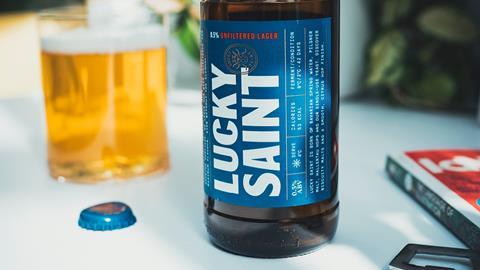Dry January is upon us once again. And, as usual, a flurry of alcohol-free launches are poised to capitalise on the occasion, from both small suppliers like Bach 95 and brewing giants like Asahi.
But in this increasingly crowded marketplace, one low & no brand is standing out: Lucky Saint. The brand has just secured a “record-breaking” £10m investment, which it claims is the “largest ever” raised by an alcohol-free beer brand, as it begins its second year as the official beer of Dry January.
That official title – one that involved a mass sampling campaign with Dry January organiser Alcohol Change UK last year – is just one driver of its success. So how has Lucky Saint got quite so lucky?
The past few years have shown that Lucky Saint has, in many ways, made its own luck. The pandemic was a prime example of its ability to adapt to a rapidly changing environment. Having focused heavily on the on-trade, Lucky Saint lost 70% of its volumes overnight when pubs and bars were forced to close.
It could have been a crisis point. But the brand responded quickly with a change in strategy. Founder Luke Boase explains the team put “our energies into our other channels” and growing its DTC business. As a result, the brand delivered a 300% surge in revenues in the same year.
Retail was the next focus. In September 2021, Lucky Saint started pouring its beer into a 330ml can format, in a bid to appeal to convenience stores and other off-trade retailers, and ranged its beers in the chillers of smaller stores to appeal to on-the-go consumers.
Things ramped up a notch in April 2022, when it secured a listing in Tesco, followed by a listing in Waitrose in May. As a result, sales of its alcohol-free lager soared nearly nine-fold in retail last year, to a total £1.5m [NielsenIQ 52 w/e 11 September 2022].
Granted, this pales in comparison with the largest non-alcoholic lager – Heineken 0.0 – which last year boasted retail sales of £25.5m. But when it comes to positioning, Lucky Saint has one advantage that the likes of Heineken and Guinness don’t. While these big names benefit from brand power, their low & no creations risk being written off as poor imitations of their alcoholic brews. Pureplay alcohol-free brands like Lucky Saint, by contrast, are free from such comparisons.
And among the challengers, Lucky Saint has successfully established itself as a clear leader. Behind this is a simple and effective product. Crucially, it has stuck to one core variant since its 2018 launch, rather than diversifying its range and risking losing focus. As summed up by Nick Woods, strategy & creative director at communications agency Sunny Side Up: “Lucky Saint has one variant and is to be all the more admired for it.”
Its 330ml glass bottles also give the brand a distinctive look and feel – one that sets it apart from the somewhat uninspiring-looking packaging of its rivals.
And the brand continues to adapt to circumstances. Now pubs are back in full swing, it’s refocusing its efforts on accelerating the distribution of its draught offering, and is even opening a dedicated Lucky Saint pub at its headquarters in central London later this month.
If it keeps up this momentum, alcohol-free rounds – of beer, as well as funding – look set to be far more plentiful.




















1 Readers' comment